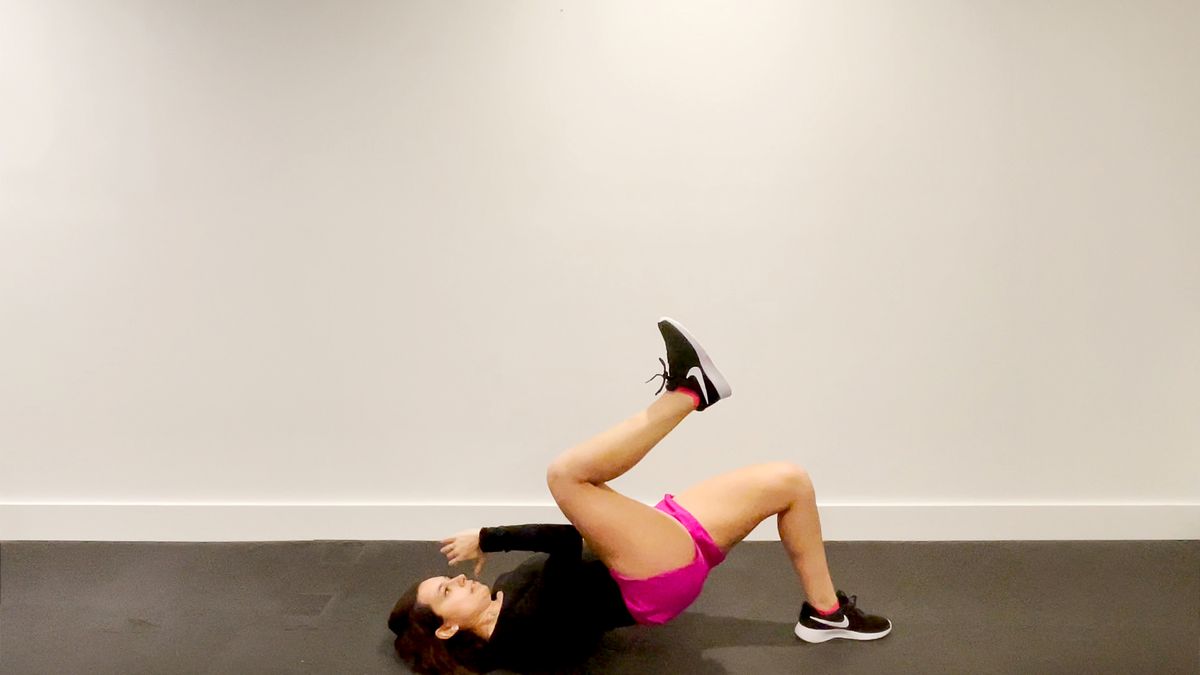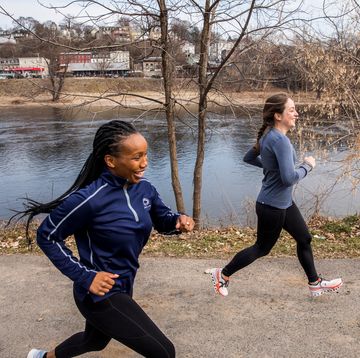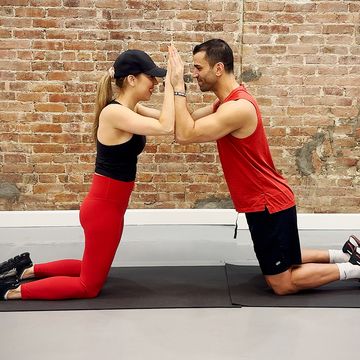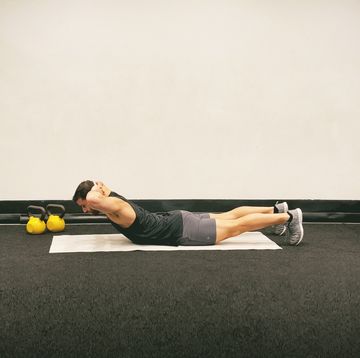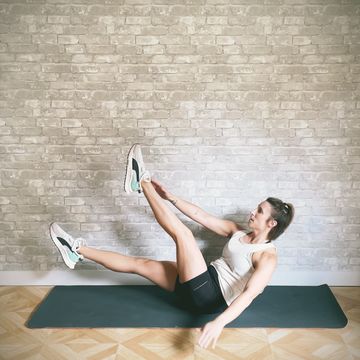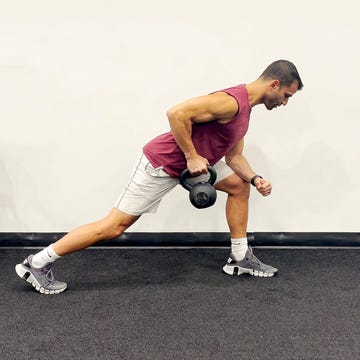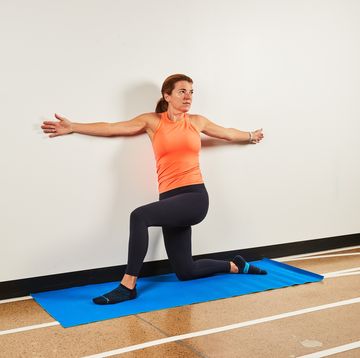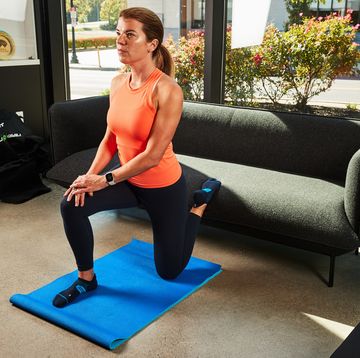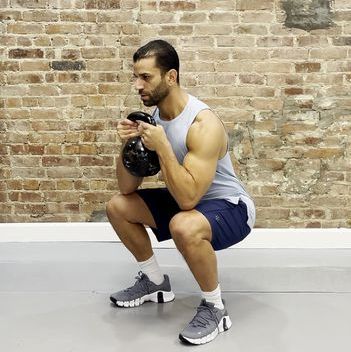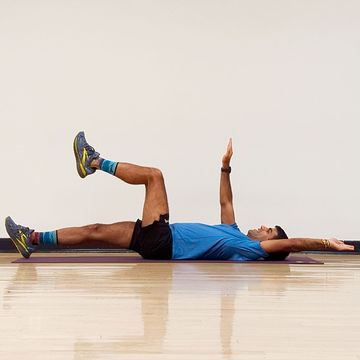Hip extension exercises build up our often neglected posterior chain—the muscles on the back of the body. Balancing your strength routine with moves that focus on your backside is important to maintain a stable pelvis and keep those legs moving fast and efficiently.
While hip flexors (front of the body) often get a lot of our attention (because, tightness and aches!), the hip extensors can always use more love. “Hip extension exercises are integrally important for runners,” says Samantha Rothberg, C.S.C.S., certified strength coach and triathlete. “This movement pattern strengthens the muscles—the glutes and hamstrings—we need strong to ensure a safe and efficient gait on the run.”
More specifically, the gluteus maximus (the biggest muscle of the backside), drives the push-off phase of the running gait. “It also stabilizes the hips on the run to keep the low back, knees, and ankles safe,” Rothberg explains. Meanwhile, the hamstrings extend the leg in your midstance and also add force behind your push-off.
The Benefits of These Hip Extension Exercises for Runners
As Rothberg mentioned, the big power players that drive hip extension include your glute muscles (of the butt) and your hamstrings (on the back of the upper thighs). “These large posterior chain muscles are often under trained in favor of anterior muscles, such as the quadriceps and hip flexors, upon which we are over reliant because of poor posture and a sedentary lifestyle,” Rothberg explains. “Utilizing these large muscles [on the back of the body] is more efficient, will produce more power, and could help to prevent an overuse injury.”
Balancing out your lower body with hip extension exercises creates that efficiency in your stride by allowing all muscle groups to work at their best and add force to your steps. This also means you work better rather than harder to reach faster speeds, Rothberg adds.
How to use this list: Do each exercise below for 4 sets of 8-10 reps. If it is a single-sided exercise, go for 8-10 reps per side.
You will need a kettlebell or a heavy dumbbell for this workout. You’ll also need a barbell, but you can use a kettlebell or dumbbell in place of that, as well. An exercise mat is optional.
Rothberg demonstrates the exercises in the video above so you can learn proper form.
1. Single-Leg Glute Bridge
Why it works: Running is a single-leg sport and strengthening the legs one at a time prevents imbalances and helps you sidestep injury, Rothberg says. “Driving the elbow into the quad also ensures that the core is engaged and that you are driving through the down heel, and not kicking up to the sky with the elevated leg,” she adds.
How to do it:
- Lie faceup, knees bent and feet planted. Place left arm down by side. Lift right knee and bend right elbow. Touch right knee to right elbow, driving them into each other. This is your starting position.
- Drive through left heel to lift hips up.
- Engage glutes to lift hips; avoid lifting with low back.
- Slowly lower back down to starting position.
- Repeat. Then switch sides.
2. Deadlift
Why it works: “This exercise targets the entire posterior chain, teaches you to push off the ground effectively, which is important for running, and can be loaded and scaled as appropriate for your lifting level,” Rothberg says.
How to do it:
- Stand with feet hip-width apart, holding a kettlebell or dumbbell with both hands in front of hips.
- Hinge at hips by sending butt straight back, keeping back flat and core engaged. Keep weight close to body, reaching toward feet.
- Drive through feet and engage glutes to stand back up, extending hips.
- Repeat.
3. Kickstand Deadlift
Why it works: This deadlift variation also brings in a unilateral element, helping you strengthen one leg at a time. This helps keep your muscles symmetrical, Rothberg says, while providing the same benefits as a regular deadlift.
How to do it:
- Stand with feet hip-width apart, holding a kettlebell or dumbbell with both hands in front of hips.
- Step right foot back, so toe is in line with left heel, and keep right heel lifted. All weight should be on left leg.
- Hinge at hips by sending butt straight back, keeping back flat and core engaged. Keep weight close to body.
- Drive through left foot and engage glutes to stand back up, extending hips.
- Repeat.
4. Glute Bridge Walkout
Why it works: Adding a walkout to the glute bridge strengthens the hamstrings eccentrically, the lengthening (or lowering) phase, Rothberg explains. It also makes your glutes work isometrically, meaning they have to maintain contraction as you extend the legs. This helps to stabilize the hips, which can keep them from dipping on the run. “Many people get injured from not training the eccentric load—that’s often when they pull something,” she adds, which is why eccentric movements are so important.
How to do it:
- Lie faceup, arms down by sides, with knees bent and feet planted hip-width apart.
- Drive through heels to lift hips, engaging glutes and core. Avoid lifting with low back. Hold here.
- Step left foot forward. Then right.
- Continue alternating until legs are straight.
- Then pause and walk them back in, underneath knees.
- Lower hips.
- Repeat.
5. Barbell Romanian Deadlift
Why it works: Focus on the eccentric action of this exercise—that means slowing down the lowering phase, aiming for a five count as you go—to gain the most benefit. This helps you strengthen the posterior muscles in the lengthening phase, which increases your strength gains, Rothberg says.
How to do it:
- Stand with feet hip-width apart, holding a barbell (or two heavy dumbbells) with both hands in front of you.
- Hinge at hips by sending butt straight back, keeping back flat and core engaged. Move slowly, on a count of 5. Keep weight close to body.
- Drive through feet and engage glutes to stand back up, extending hips.
- Repeat.
Mallory Creveling, an ACE-certified personal trainer and RRCA-certified run coach, joined the Runner's World and Bicycling team in August 2021. She has more than a decade of experience covering fitness, health, and nutrition. As a freelance writer, her work appeared in Women's Health, Self, Men's Journal, Reader's Digest, and more. She has also held staff editorial positions at Family Circle and Shape magazines, as well as DailyBurn.com. A former New Yorker/Brooklynite, she's now based in Easton, PA.
